In just the span of barely the first three weeks of September, four lawsuits suing energy companies for the costs of man-caused global warming were filed, City of Hoboken v. ExxonMobil, et al. (9/2/20), City of Charleston v Brabham Oil Company, et al. (9/9/20), Delaware v. BP America Inc, et al. (9/10/20), and Connecticut v. ExxonMobil Corp. (9/14/20). These allege the companies knew their products caused harm from global warming while orchestrating disinformation campaigns with ‘shill’ experts to deceive the public about the harm. Politico summarized these in a September 16 podcast report as part of a “new wave of climate change lawsuits” against fossil fuel companies “racking up nationwide.” While no comparison was offered in that report to the way the tobacco industry began to crumble under the weight of lawsuits against it in the 1990s, a same-day report from E&E News was not the least bit subtle about prompting readers to consider how this “growing body of climate misinformation suits” compares to the tobacco industry’s situation over its knowledge of the harm of cigarette smoking. No mention was made in either report, of course, regarding dubious claims about the allegedly ‘settled science’ of man-caused global warming.
It’s arguably disingenuous for reporters to suggest this is settled science when extensive science-based opposition exists. David Middleton’s September 14 “Charleston SC Junk Climate Lawsuit” WUWT guest post addressed many of the opposition’s viewpoints, including some details concerning a ‘cartoonly absurd’ graph in this Charleston v Brabham Oil filing. In his remarks about the graph’s appearance elsewhere, Middleton basically exposed a sizable problem with reporters disingenuously implying there is a ‘wave of individual state and city-filed lawsuits’ happening:
This cartoon appears on page 62 of this, and nearly every other, junk climate lawsuit .. The exact same image, including the caption is in Delaware’s recent junk lawsuit. The graph is from what is known as the “Black presentation” and supposedly reveals Exxon’s secret knowledge of climate change …
It does indeed appear identically on page 77 in Delaware v. BP, and Middleton isn’t exaggerating about the number of lawsuits referencing that graph and/or material directly stemming from it. While the graph itself does not appear in the four Matt Pawa-led lawsuits, the Black Report is noted in the text of the lawsuits, King County v. BP example here, where the source link goes to Inside Climate News’ (ICN) PDF file containing the James Black quote about “Present thinking holds that man has a time window of five to ten years…” at the bottom of its PDF page 3, and the graph in its PDF page 26.
ICN is the obvious source; many enviro-activists say their “Exxon Knew” series of articles (with a massively repeated Twitter hashtag) is the be-all / end-all source for incriminating documents, where their particular 9/17/15 article was the first with the direct link to their PDF file copy of the Exxon memos which King County uses, along with other global warming lawsuits. For example, the supposedly ‘independently led’ Hoboken v. ExxonMobil lawsuit uses the same “time window of five to ten years” quote, but takes a slightly more circuitous citation path about it by linking to an ICN web page link which itself then links to ICN’s PDF file containing the quote and graph. The days-old ‘also-supposedly-independently-led’ Connecticut v Exxon 9/14/20 filing quotes the same Black Report “time window” sentence, but skips the trouble of including any sort of citation source altogether. The supposedly independently led D.C. v Exxon is also devoid of citation sources, and doesn’t even bother to assign a name to the Black Report’s warning about “double to triple as much warming at the poles,” where their passage about it bears a striking resemblance to a similar passage in the Hoboken filing ……. which cites ICN as the source for it.
The similarities don’t stop there. What other lawsuit looks like that? The ‘also-supposedly-independently-led’ Minnesota v American Petroleum Institute, Exxon, et al. lawsuit does, but with a twist on the citation source which is not Inside Climate News:
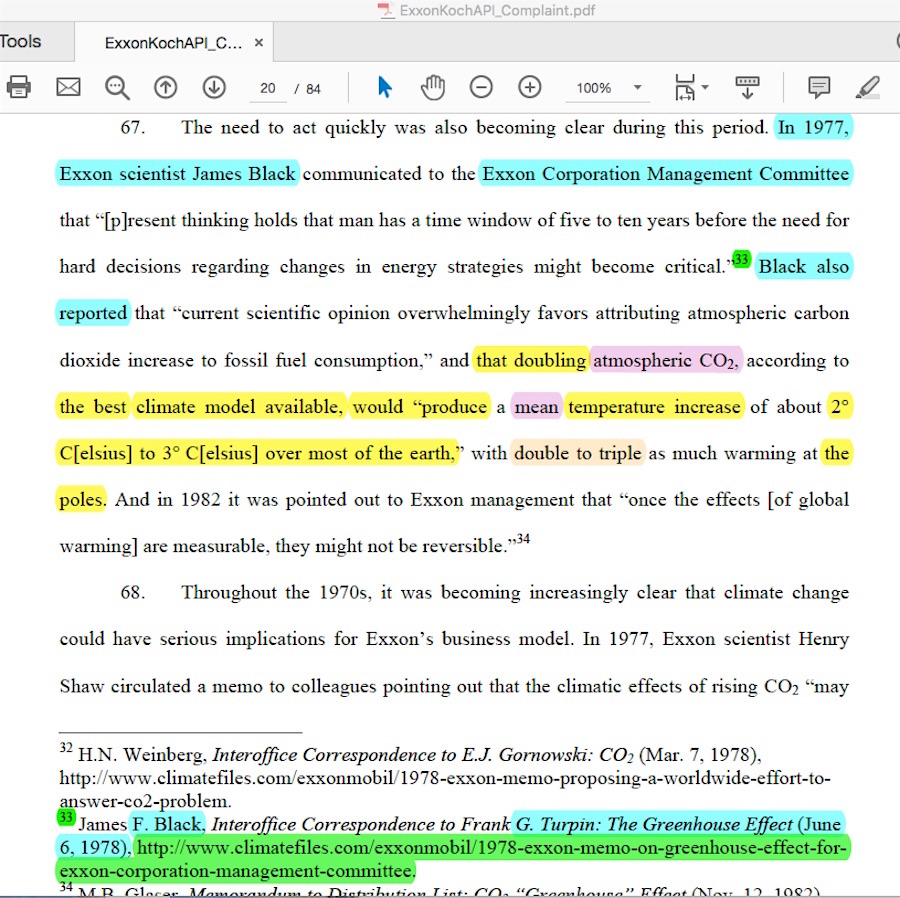
Where else is such a similar “mean temperature / poles temperature” passage found in the pile of global warming lawsuits accusing ‘Big Coal & Oil’ of colluding with skeptic climate scientists in disinformation campaigns?
Remember how WUWT post contributor David Middleton noted the ‘cartoonly absurd’ “mean temperature / poles temperature” graph is seen in the Charleston filing and identically in the Delaware filing? Read the text accompanying that graph in Charleston, and in Delaware, and in the Honolulu v. Sunoco filing, and what do you see?
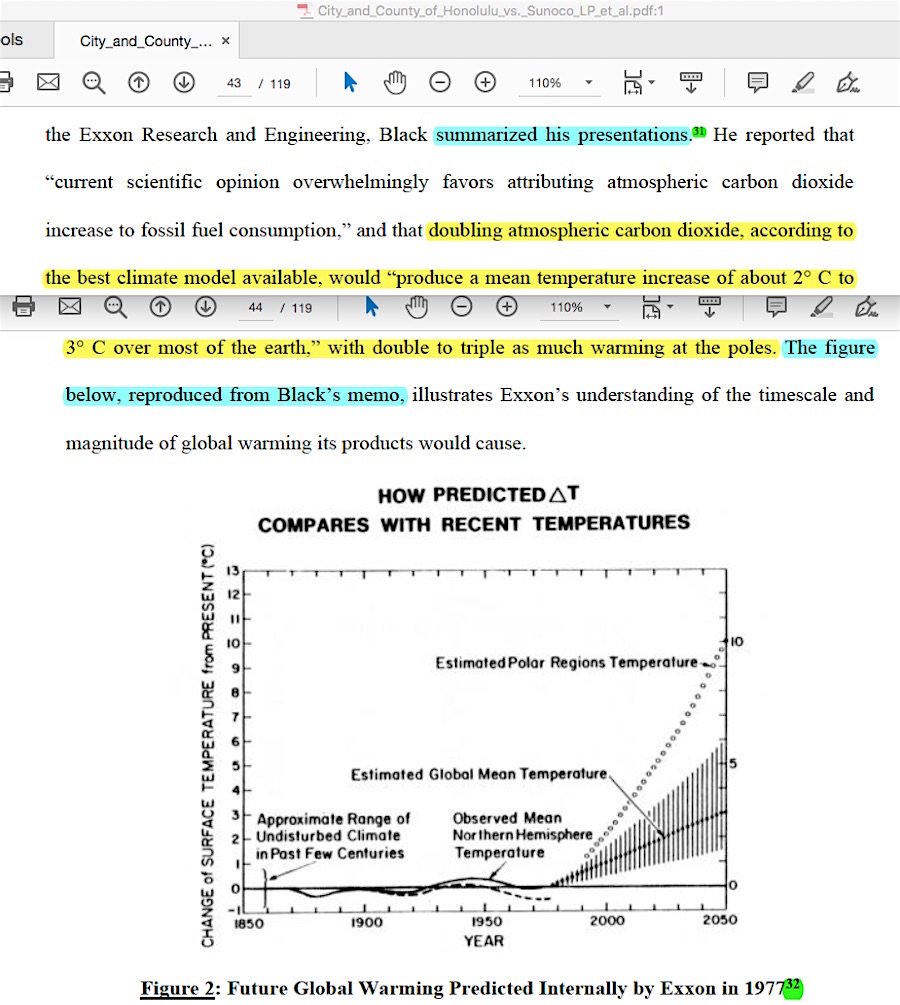
There’s that text again, identical to what’s in the sourceless passage in D.C. and naturally identical in these three Sher Edling boilerplate copy lawsuits …. all three of which cite Kert Davies’ ClimateFiles as the source for the text and graph.
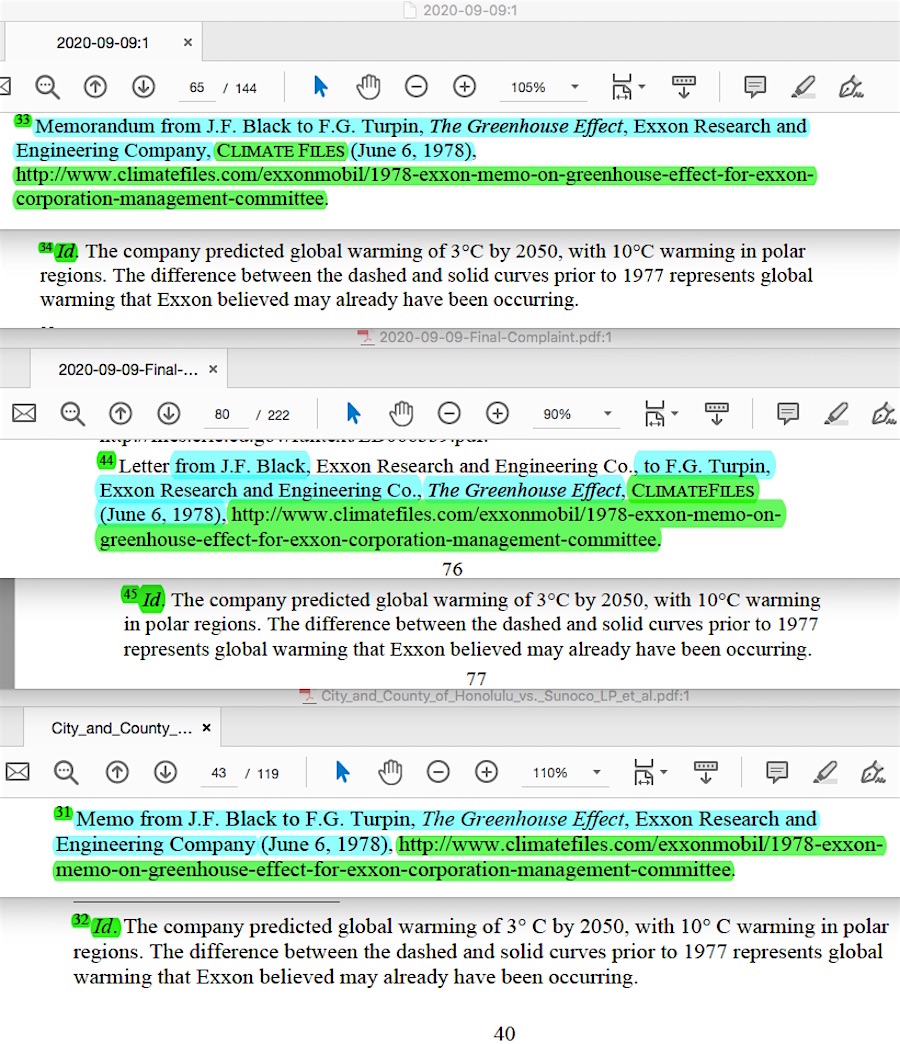
It’s a potential point of speculation on whether the taxpaying citizens of Delaware and Charleston might be disappointed that they are blessed with what could be described as a used, hand-me-down lawsuit from a city halfway out into the Pacific Ocean. But the citizens of Honolulu might make the same argument about their own lawsuit filing being a hand-me-down through eight prior generations of essentially identical filings dating all the way back to 2017’s County of San Mateo v. Chevron, with its variant of the Black Report / Kert Davies Climate Files passage, and its repeated-in-every-subsequent-filing-elsewhere implication that a leaked memo set with the strategy goal to “reposition global warming” is evidence to prove the existence of fossil fuel industry disinformation campaigns. I’ve covered the crippling problems with that latter ‘worthless leaked memos’ situation and how they are connected to the time when Kert Davies worked at Ozone Action in every one of my dissections of these Sher Edling lawsuit filings.
Speaking of Kert Davies’ Climate Files website link for Black Report material versus the other filings’ links to Inside Climate News’ PDF file for the same material, there is an odd thing going on within Sher Edgings’ first six filings for San Mateo / Marin Counties / City of Imperial Beach v. Chevron and Santa Cruz City / County / City of Richmond v. Chevron. As seen in the prior paragraph’s screencapture for San Mateo, they all identically link to Kert Davies’ site regarding the Black Report’s “time window” / “warming at the poles” line. But all six filings also feature an attachment cleverly titled “Exhibit A Truth or CO2nsequences,” which is a list of clickable links for a “timeline [that] highlights information … from key industry documents and other sources.” The specific info for the “Exhibit A Black Report” entry is the same wording as the main text in all six filings ……. except the link for it goes to Inside Climate News instead of Kert Davies’ website.
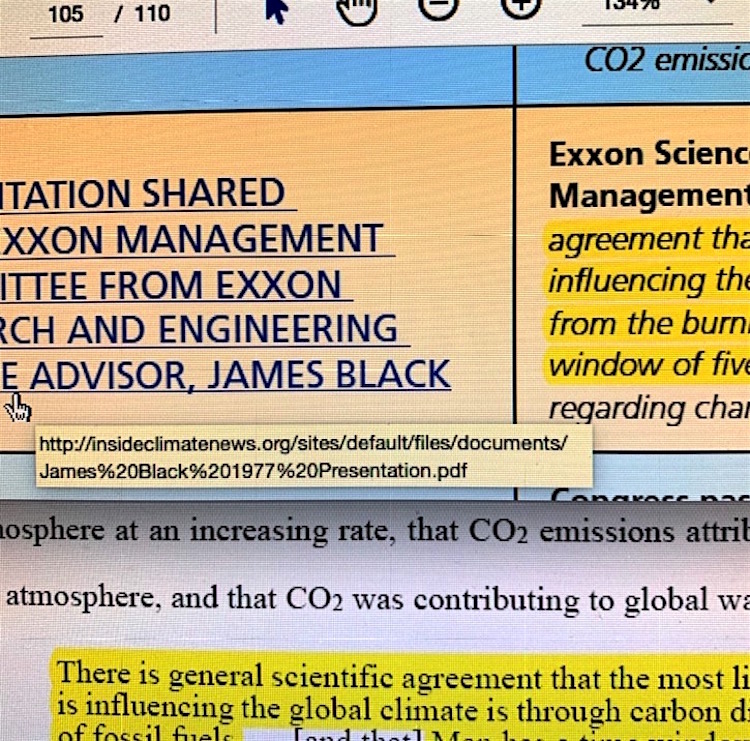
What’s up with that?
Is there something special about Kert Davies’ Black Report scans that are different than ICN’s scans? No, they are identical. Notice the little orange diagonal smudge and four surrounding dots at the top right corner of page 1 in both collections.
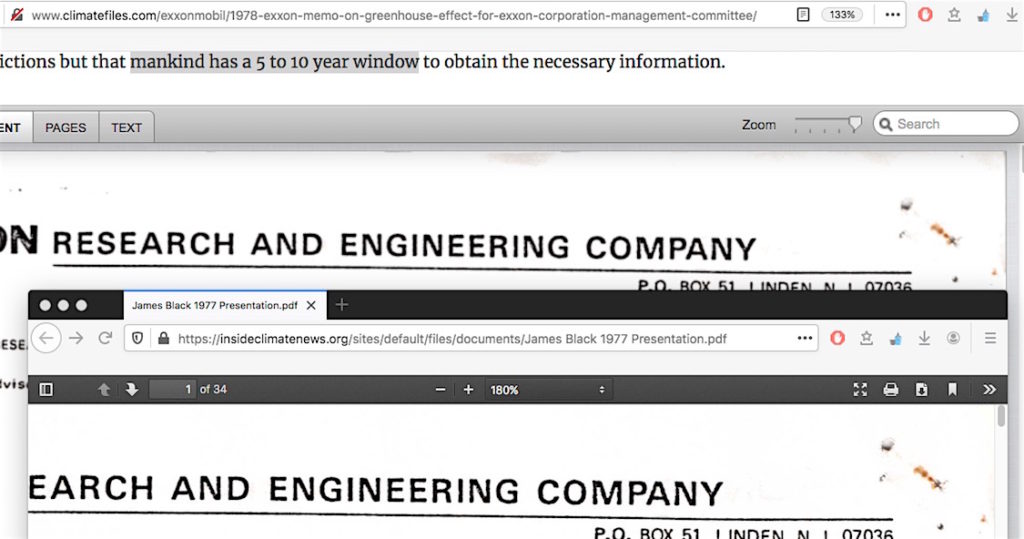
If the ICN “Exxon Knew” report series was the – again – be-all, end-all source for old Exxon documents, why would there be any need to create a new ‘Kert Davies middleman source’ between these lawsuits and those document scans? Then there’s the counter opposite question about why these Sher Edling filings, including this latest Charleston one, all link to the ‘middleman source’ of the Union of Concerned Scientists for the scans of the worthless “reposition global warming memos” when they could instead link to Kert Davies’ scan copies from – again – the time when he worked at Ozone Action, where it and Ross Gelbspan ‘obtained’ those memos from a never-disclosed source.
These global warming lawsuit filings are anything but “open and shut cases.” David Middleton and others point out sizable problems regarding what Exxon supposedly knew about the science, while others point out the problems with the operation and personnel behind these lawsuit filings. Myriad questions arise from all of this, which the defendant lawyers or prominent objective reporters might want to explore:
- was the “September mini-wave” of global warming lawsuit filings less of a ‘wave’ if two of the four are identical, handled by the same law firm?
- is the overall “wave” of global warming lawsuit filings over the last three years far less of a ‘wave’ if over half of them apparently consist of pick-and-choose boilerplate copy elements from a single template that one law firm is using in its multiple filings, while the rest of the filings seemingly rely on an arguably too-similar-to-be-coincidental basic template? (not mentioned above, both Boulder v Suncor and Massachusetts v Exxon, each devoid of citation sources, vaguely reference what turns out to be obviously the Black Report)
- is there actually any ‘wave’ of lawsuits at all, when every one of these “Exxon Knew”-style lawsuits are similar enough that they could be consolidated into a single one of John Passacantando, Kert Davies, et al. [dba Greenpeace USA née Ozone Action / Our Next Economy / CIC ] v Exxon, considering how that duo and their apparent associates don’t like Exxon very much, and how they may actually be the central leaders over the last 22 years behind the idea of ‘suing the fossil fuel industry for using counter-propaganda campaigns to deceive the public.’
- is there a reason why university analysts and supposedly unbiased news reporters are unable to spot myriad faults which potentially fatally weaken these “climate misinformation lawsuits,” which otherwise become obvious after even just a moderately objective examination is undertaken of the finer points of the scientific part or the political part of the lawsuits?
